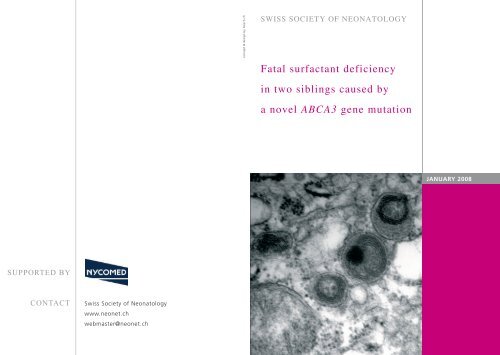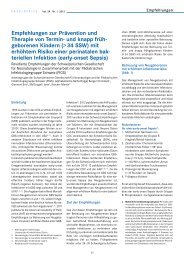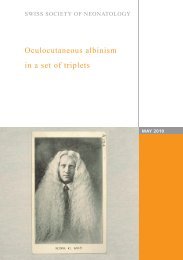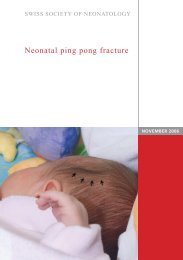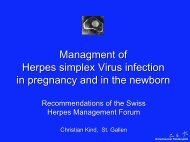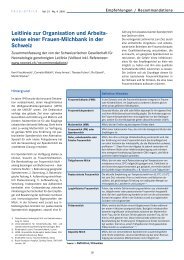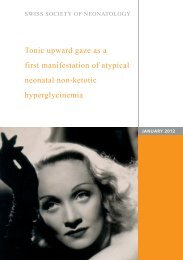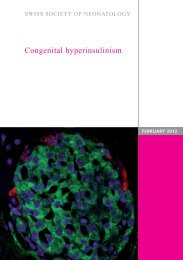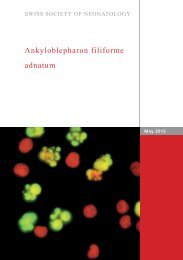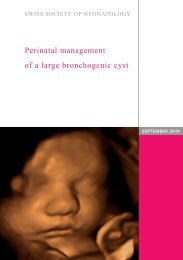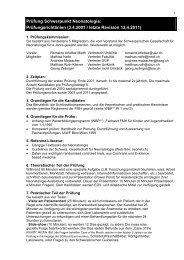Fatal surfactant deficiency in two siblings caused by a novel ABCA3 ...
Fatal surfactant deficiency in two siblings caused by a novel ABCA3 ...
Fatal surfactant deficiency in two siblings caused by a novel ABCA3 ...
Create successful ePaper yourself
Turn your PDF publications into a flip-book with our unique Google optimized e-Paper software.
SUPPORTED BY<br />
CONTACT<br />
Swiss Society of Neonatology<br />
www.neonet.ch<br />
webmaster@neonet.ch<br />
concept & design <strong>by</strong> mesch.ch<br />
SWISS SOCIETY OF NEONATOLOGY<br />
<strong>Fatal</strong> <strong>surfactant</strong> <strong>deficiency</strong><br />
<strong>in</strong> <strong>two</strong> sibl<strong>in</strong>gs <strong>caused</strong> <strong>by</strong><br />
a <strong>novel</strong> <strong>ABCA3</strong> gene mutation<br />
JANUARY 2008
Hofmeister J, Bruder E, Aslanidis C, Hammer J,<br />
Schmitz G, Bührer C, Department of Neonatology<br />
(HJ, BC), University Children‘s Hospital of Basel,<br />
Institute of Pathology (BE), University Hospital of<br />
Basel, Institute for Cl<strong>in</strong>ical Chemistry (AC), Regensburg<br />
University Medical Center, Department of Pediatric<br />
Pneumonology (HJ), University Children‘s Hospital<br />
of Basel<br />
© Swiss Society of Neonatology, Thomas M Berger, Webmaster<br />
Pulmonary <strong>surfactant</strong> lowers surface tension and pre-<br />
vents atelectasis at end-expiration. It is composed of<br />
phospholipids and prote<strong>in</strong>s synthesized with<strong>in</strong> type II<br />
cells. The mixture is packaged <strong>in</strong>to specialized orga-<br />
nelles called lamellar bodies which are extruded <strong>in</strong>to<br />
the alveolar lumen <strong>by</strong> exocytosis.<br />
A complex and tightly regulated cycle of synthesis,<br />
process<strong>in</strong>g, transport, secretion, degradation, re-up-<br />
take or clearance and reprocess<strong>in</strong>g <strong>in</strong>volves both the<br />
phospholipids and prote<strong>in</strong> components of pulmonary<br />
<strong>surfactant</strong>.<br />
Defective synthesis of the essential <strong>surfactant</strong> compo-<br />
nent <strong>surfactant</strong> prote<strong>in</strong>-B, or impaired lamellar body<br />
transport leads to fatal neonatal lung disease. At pre-<br />
sent, mutations <strong>in</strong> genes, encod<strong>in</strong>g <strong>surfactant</strong> prote-<br />
<strong>in</strong>-B (SP-B) or ATP b<strong>in</strong>d<strong>in</strong>g cassette transporter family<br />
member ABCA , have been shown to underlie fatal<br />
hereditary neonatal <strong>in</strong>terstitial lung disease. While SP-B<br />
is <strong>in</strong>dispensable for <strong>surfactant</strong> function, the lipid transporter<br />
ABCA targets <strong>surfactant</strong> phospholipids to the<br />
lamellar bodies and is necessary for lamellar body biogenesis,<br />
SP-B process<strong>in</strong>g and lung development late<br />
<strong>in</strong> gestation (1). Here, we present the cl<strong>in</strong>ical course of<br />
<strong>two</strong> related <strong>in</strong>fants who succumbed from severe hypoxemic<br />
respiratory failure <strong>caused</strong> <strong>by</strong> a <strong>novel</strong> mutation <strong>in</strong><br />
the ABCA gene.<br />
INTRODUCTION
FIGURES<br />
Fig. 1<br />
* <strong>ABCA3</strong> gene was sequenced<br />
2000, GA 1+1 weeks<br />
weight 6 0 g, Apgar 8/9/10<br />
<strong>in</strong>tubation on th day of life<br />
died after 1/ month<br />
2006, GA 0+6 weeks<br />
weight 1 0 g, Apgar 9/9/8<br />
<strong>in</strong>tubation on rd day of life<br />
died after days<br />
uncl. cases of death at<br />
6 to 1 months of life
CASE REPORTS<br />
We report on <strong>two</strong> <strong>in</strong>fants of an <strong>in</strong>bred Algerian family<br />
born after uneventful pregnacies <strong>in</strong> 000 and 006.<br />
There were also <strong>two</strong> healthy girls born to that family <strong>in</strong><br />
1996 and 001 (Fig. 1).<br />
The first case was a hypotrophic girl born after 1 weeks<br />
of gestation, birth weight 6 0 g (P
Fig. 2A<br />
Chest X-ray of the affected boy born <strong>in</strong> 2006:<br />
day 1 of life<br />
8 9<br />
Chest X-ray of the affected boy born <strong>in</strong> 2006:<br />
day 3 of life<br />
Fig. 2B
Fig. 2C<br />
Chest X-ray of the affected boy born <strong>in</strong> 2006:<br />
day 11 of life<br />
10 11<br />
Chest X-ray of the affected boy born <strong>in</strong> 2006:<br />
day 33 of life<br />
Fig. 2D
Fig. 2E<br />
Chest X-ray of the affected boy born <strong>in</strong> 2006:<br />
day 55 of life<br />
1 1<br />
On day 11 of life, an open lung biopsy was done and<br />
the material went through histological, ultrastructural<br />
and histochemical exam<strong>in</strong>ations (Fig. , ). On conventional<br />
light microscopy, there was marked <strong>in</strong>terstitial fibrosis<br />
with widened <strong>in</strong>teralveolar septa (Fig. A), type<br />
II pneumocyte hyperplasia and PAS-positive material <strong>in</strong><br />
the alveoli (Fig. B).<br />
Transmission electron microscopy showed rare cytoplasmic<br />
<strong>in</strong>clusions with concentric membranes and eccentrically<br />
placed electron-dense aggregates (Fig. ). These<br />
«fried-egg»-appear<strong>in</strong>g lamellar bodies differed both<br />
from normal lamellar bodies and the larger, poorly formed<br />
composite bodies with multiple vesicular <strong>in</strong>clusions<br />
observed <strong>in</strong> <strong>surfactant</strong> prote<strong>in</strong>-B <strong>deficiency</strong>. Details<br />
of the ultrastructural f<strong>in</strong>d<strong>in</strong>gs are be<strong>in</strong>g described elsewhere<br />
( ).<br />
Prompted <strong>by</strong> the ultrastructural f<strong>in</strong>d<strong>in</strong>g, the ABCA<br />
gene was sequenced, which revealed a <strong>novel</strong> mutation<br />
<strong>in</strong> the th exon ( 8C>G) lead<strong>in</strong>g to an exchange of<br />
19 prol<strong>in</strong> to 19 arg<strong>in</strong><strong>in</strong>e. The patient was homozygous<br />
for this mutation, while both his parents, one of his<br />
phenotypical healthy sisters and one maternal grandmother<br />
were heterozygous. DNA extracted from paraf<strong>in</strong>embedded<br />
tissue of his dead sister showed her to have<br />
been homozygous for the same mutation (Fig. 1).
Fig. 3A<br />
Fig. 3B<br />
Histology of open lung biopsy specimen shows <strong>in</strong>-<br />
terstitial fibroplasia with widened <strong>in</strong>teralveolar septa<br />
and collapsed alveoli.<br />
Alcian Blue PAS sta<strong>in</strong> demonstrates alveolar prote<strong>in</strong>osis<br />
(<strong>in</strong>traalveolar PAS-positive deposits) and type II pneu-<br />
mocyte hyperplasia.<br />
1 1<br />
Transmission electron microscopy show<strong>in</strong>g lamellar<br />
bodies with «fried egg» appearance<br />
Fig. 4
DISCUSSION The cl<strong>in</strong>ical presentations of our <strong>two</strong> patients are typical<br />
for <strong>in</strong>fants with loss-of-function mutations <strong>in</strong> SFTP-B or<br />
ABCA genes ( , ). Because there is significant overlap<br />
<strong>in</strong> the cl<strong>in</strong>ical presentation of these <strong>in</strong>herited disorders<br />
of <strong>surfactant</strong> metabolism, a comb<strong>in</strong>ed tissue-based and<br />
genetic approach to diagnosis is warranted.<br />
Term newborns with unexpla<strong>in</strong>ed respiratory distress<br />
syndrome who require mechanical ventilation for more<br />
than – days without apparent signs of improvement<br />
should be considered for evaluation, sooner if extracorporeal<br />
membrane oxygenation (ECMO) is used or if<br />
there is a family history of lung disease.<br />
A lung biopsy helps to dist<strong>in</strong>guish disorders of <strong>surfactant</strong><br />
metabolism from other structural causes of lung<br />
disease such as alveolar capillary dysplasia ( ). At the<br />
time of biopsy, tissue should be processed for electron<br />
microscopy to evaluate lamellar body morphology, and<br />
tissue should also be frozen <strong>in</strong> liquid nitrogen to be preserved<br />
for future molecular and proteomic analyses as<br />
new mechanisms of lung disease are identified.<br />
Us<strong>in</strong>g electron microscopy with its ultrastructural hallmarks<br />
provides an important branch po<strong>in</strong>t <strong>in</strong> direct<strong>in</strong>g<br />
a more focused genetic evaluation. Disorganized or unrecognizable<br />
lamellar bodies and an accumulation of<br />
abnormal-appear<strong>in</strong>g multivesicular bodies suggest SPB<br />
<strong>deficiency</strong>, while small lamellar bodies with electrondense<br />
<strong>in</strong>clusions («fried-eggs») suggest ABCA <strong>deficiency</strong>.<br />
16 1<br />
ABCA <strong>deficiency</strong>, first described <strong>in</strong> 00 as a cause of<br />
fatal <strong>in</strong>terstitial lung disease <strong>in</strong> newborn <strong>in</strong>fants (6), now<br />
appears to account for the majority of cases of hereditary<br />
fatal neonatal lung disease ( ), and new disease-caus<strong>in</strong>g<br />
mutations cont<strong>in</strong>ue to be discovered (8).<br />
The availability of molecular diagnosis also permits genetic<br />
counsel<strong>in</strong>g for affected families <strong>in</strong> order to discuss<br />
the risks for future pregnancies and to convey the risks<br />
for other family members. In families <strong>in</strong> which a mutation<br />
has been previously identified, antenatal diagnosis<br />
can be established and permits advanced plann<strong>in</strong>g of a<br />
palliative regimen.
REFERENCES 1. Cheong N, Zhang H, Muniswamy M, Zhao M, Yu K, Dodia C,<br />
Fisher AB, Savani RC, Shuman H. ABCA is critical for lamellar<br />
body biogenesis <strong>in</strong> vivo. J Biol Chem 00 [Epub ahead of pr<strong>in</strong>t]<br />
. Bruder E, Hofmeister J, Aslanidis C, Hammer J, Bubendorf L,<br />
Schmitz G, Rufle A, Bührer C. Ultrastructural and molecular<br />
18<br />
analysis <strong>in</strong> fatal neonatal <strong>in</strong>terstitial pneumonia <strong>caused</strong> <strong>by</strong> a <strong>novel</strong><br />
ABCA mutation. Mod Pathol 00 [<strong>in</strong> press]<br />
. Hamvas A, Cole FS, Nogee LM: Genetic disorders of <strong>surfactant</strong><br />
prote<strong>in</strong>s. Neonatology 00 ;91: 11- 1<br />
. Nogee LM. Genetics of pediatric <strong>in</strong>terstitial lung disease.<br />
Current Op<strong>in</strong>ion <strong>in</strong> Pediatrics 006;18: 8 - 9<br />
. Brasch F, Brasch F, Schimanski S, Mühlfeld C, Barlage S,<br />
Langmann T, Aslanidis C, Boettcher A, Dada A, Schroten H,<br />
Mildenberger E, Prueter E, Ballmann M, Ochs M, Johnen G,<br />
Griese M, Schmitz G. Alteration of the pulmonary <strong>surfactant</strong><br />
system <strong>in</strong> full-term <strong>in</strong>fants with hereditary ABCA <strong>deficiency</strong>.<br />
Am J Respir Crit Care Med 006;1 : 1- 80<br />
6. Shulen<strong>in</strong> S, Nogee LM, Annilo T, Wert SE, Whitsett JA, Dean M.<br />
ABCA gene mutations <strong>in</strong> newborns with fatal <strong>surfactant</strong><br />
<strong>deficiency</strong>. N Engl J Med 00 ; 0:1 96-1 0<br />
. Somasch<strong>in</strong>i M, Nogee LM, Sassi I, Danhaive O, Presi S, Boldr<strong>in</strong>i<br />
R, Montrasio C, Ferrari M, Wert SE, Carrera P. Unexpla<strong>in</strong>ed<br />
neonatal respiratory distress due to congenital <strong>surfactant</strong><br />
<strong>deficiency</strong>. J Pediatr 00 ;1 0:6 9-6<br />
8. Saugstad OD, Hansen TW, Rønnestad A, Nakstad B, Tølløfsrud<br />
PA, Re<strong>in</strong>holt F, Hamvas A, Coles FS, Dean M, Wert SE, Whitsett<br />
JA, Nogee LM. Novel mutations <strong>in</strong> the gene encod<strong>in</strong>g ATP b<strong>in</strong>d<strong>in</strong>g<br />
cassette prote<strong>in</strong> member A (ABCA ) result<strong>in</strong>g <strong>in</strong> fatal neonatal<br />
lung disease. Acta Pædiatr 00 ;96:18 -190


